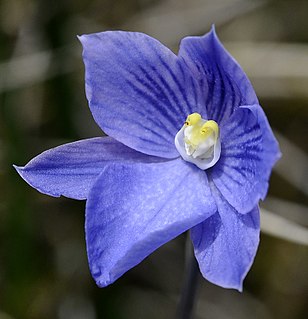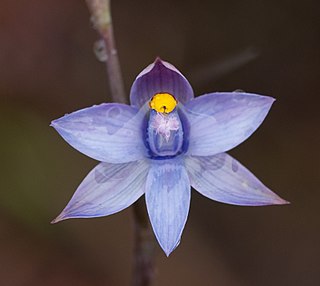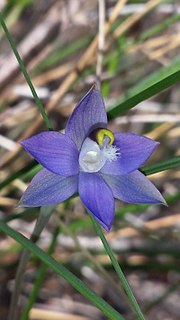
Thelymitra cyanea, commonly known as the veined sun orchid in Australia and as the swamp sun orchid or striped sun orchid in New Zealand, is a species of orchid which is native to New Zealand and south-eastern Australia. It has a single erect, fleshy, channelled leaf and up to five bright blue flowers with darker blue veins. It is usually found growing in swamps, sphagnum bogs, and subalpine herbfields, often in clonal colonies.

Thelymitra malvina, commonly called the mauve-tufted sun orchid, is a species of orchid that is native to eastern Australia and New Zealand. It has a single large, fleshy leaf and up to twenty five blue to mauve flowers with pink or mauve tufts on top of the anther.
Thelymitra queenslandica, commonly called the northern sun orchid, is a species of orchid that is endemic to Queensland. It has a single long, grass-like leaf and up to fifteen dark blue to purplish, sometimes white or pinkish flowers with white or pink tufts on top of the anther. It is readily distinguished by its northerly distribution and early flowering period.

Thelymitra brevifolia, commonly called the peppertop sun orchid or short-leaf sun orchid, is a species of orchid that is endemic to south-eastern Australia. It has a single erect, relatively short and broad, dark green leaf and up to twenty purplish or purplish blue flowers. It is a common and widespread self-pollinating species occurring in a wide range of habitats.
Thelymitra planicola, commonly called the glaucous sun orchid, is a species of orchid that is endemic to southern eastern Australia. It has a single erect, leathery, channelled, dark green leaf and up to twelve blue flowers with darker veins. The plant has a bluish green hue and the flowers are self-pollinating, only opening widely on hot days.
Thelymitra vulgaris, commonly called the slender sun orchid or common sun orchid, is a species of orchid in the family Orchidaceae and endemic to the south-west of Western Australia. It has a single erect, dark green leaf and up to nine relatively small, blue to purplish or white flowers.
Thelymitra inflata, commonly called the inflated sun orchid, is a species of orchid that is endemic to south eastern Australia. It has a single long, erect, linear leaf and up to six dark blue to purplish flowers with a very inflated lobe on top of the anther.

Thelymitra epipactoides, commonly called the metallic sun orchid, is a species of orchid that is endemic to south-eastern continental Australia. It has a single relatively large, leathery leaf and up to twenty large flowers that range in colour from pink to reddish but have a distinctive arrangement of lobes above the anther.
Thelymitra hiemalis, commonly called the winter sun orchid, is a species of orchid that is endemic to Victoria. It is a winter flowering orchid with greenish sepals and blue or mauve petals with large, irregular, darker spots.
Thelymitra incurva, commonly called the coastal striped sun orchid, is a species of orchid that is endemic to south-eastern Australia. It has a single erect, dark green grass-like leaf and up to seven relatively large, pale blue flowers lacking the darker veins of some other thelymitras, especially the otherwise similar striped sun orchid. It grows in coastal areas of far south-eastern New South Wales and north-eastern Victoria.

Thelymitra maculata, commonly called the spotted curly locks or eastern curly locks, is a species of orchid in the family Orchidaceae and endemic to the south-west of Western Australia. It has a single erect leaf, spiralling around the flowering stem and a single pink or purplish, spotted flower with more or less circular, yellow ear-like arms on the sides of the column.
Thelymitra spiralis, commonly called curly locks, is a species of orchid in the family Orchidaceae and endemic to the south-west of Western Australia. It has a single erect leaf, spiralling around the flowering stem and up to three pink, reddish, purplish or blue flowers with two large yellow or orange ear-like arms on the sides of the column.
Thelymitra uliginosa, commonly called southern curly locks or swamp curly locks, is a species of orchid in the family Orchidaceae and endemic to the south-west of Western Australia. It has a single erect leaf, spiralling around the flowering stem and a single small pink, mauve, blue or purplish flower with darker veins and sometimes darker blotches. There are two narrow, yellow arms on the sides of the column.

Thelymitra apiculata, commonly called Cleopatra's needles, is a species of orchid in the family Orchidaceae and endemic to the south-west of Western Australia. It has a single erect, curved, dark green leaf with a purplish base and up to twelve purplish flowers with darker blotches and golden yellow edges. There are two yellow arms on the sides of the column, each ending with a needle-like point.
Thelymitra pulcherrima, commonly called the northern Queen of Sheba, is a species of orchid in the family Orchidaceae and endemic to the south-west of Western Australia. It has a single erect, spiral, dark green leaf with a purplish base and up to seven glossy, variegated flowers with the sepals and petals differing in colour. The petals and sepals and basically reddish or purplish but with streaks and blotches of contrasting colours. There are two bright yellow or orange arms on the sides of the column.
Thelymitra speciosa, commonly called the eastern Queen of Sheba, is a species of orchid in the family Orchidaceae and endemic to the south-west of Western Australia. It has a single erect, spiral, dark green leaf with a purplish base and one or two glossy, purplish flowers with broad reddish edges and yellowish margins. There are two bright yellow or orange arms on the sides of the column.
Thelymitra atronitida, commonly called the black-hooded orchid, is a species of orchid that is endemic to south-eastern Australia. It has a single erect, leathery, leaf and up to eight moderately dark blue, self-pollinating flowers that only open on hot days.
Thelymitra variegata, commonly called the Queen of Sheba, is a species of orchid in the family Orchidaceae and endemic to the south-west of Western Australia. It has a single erect, spiral, dark green leaf with a purplish base and up to five glossy, variegated reddish, purplish or violet flowers with darker spots and blotches and yellowish margins. There are two bright yellow or orange arms on the sides of the column.
Thelymitra paludosa, commonly known as the plain sun orchid, is a species of orchid that is endemic to Western Australia. It has a single erect, channelled, dark green leaf and up to ten or more blue to violet flowers. It grows in higher rainfall areas near the south coast.
Thelymitra merraniae, known as Thelymitra × merraniae by some Australian authorities, and commonly called Merran's sun orchid, is a species of orchid that is endemic to south-eastern Australia. It has a single tapering, fleshy, channelled, dark green leaf and up to six dark blue to purplish flowers. It is a possibly a natural hybrid but its parentage is uncertain.






